What is dew point: its connection with construction + calculation methodology
The physical state of water contained in insulation materials, hygroscopic building materials, and air is affected by the ambient temperature.According to the laws of thermal engineering, the dew point is a certain temperature value at which vaporous water becomes condensate, that is, dew.
You will learn everything about how to determine the dew point in order to take it into account when developing a construction project from the article we presented. We will tell you how to calculate the point at which steam turns into condensate, and how it affects the operation of the house. We will give advice on options for localizing this phenomenon.
The content of the article:
Relationship between dew point and construction
The numerical value of the dew point is directly dependent on the following indicators: relative humidity and temperature outside and in the room itself. For example, if outside the window it is t = 8 ˚С, and inside the house it is t = 22 ˚С and the relative humidity is 45%, then condensation will form on the external wall.
There are additional factors that form the dew point, namely: features of the regional climate, the degree of insulation of all enclosing surfaces, the quality and type of heating system, period of residence - can be permanent (house, apartment) or temporary, for example, a dacha or garage, the presence of ventilation .
It is very important for builders to know the dew point number in order to calculate the exact location of condensation on the walls, as well as to determine the required thickness of insulation. After all, it is thanks to this knowledge that heat loss can be minimized during cold periods.
The dew point position may vary across the thickness of the wall. It depends on the thickness and type of materials of the wall itself and insulation, on temperature and humidity indicators indoors and outdoors.
Each material used for the construction and decoration of walls, except metal, has its own degree of vapor permeability. This indicator, from the point of view of physics, shows the amount of steam that can pass through any material in a certain time.
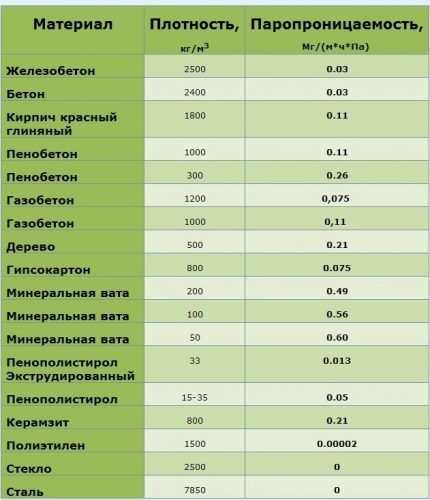
During periods of low temperatures, steam from the room under pressure will tend to pass to the street through all layers of external walls. The lower the vapor permeability coefficient of the insulation, the smaller the layer should be laid. Its coefficient should increase from the inside to the outside, just like thermal conductivity.
If all calculations are carried out without errors, then the location of the dew point will be in thermal insulation layer of the wall, closer to the outer surface. It is there that the steam will turn into condensation and only moisten the wall. Thus, steam will accumulate in winter, and in summer it is necessary to create conditions for the evaporation of accumulated moisture.
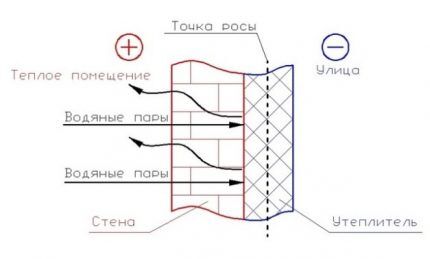
Less suitable would be the position of the dew point in the load-bearing wall of the house. This happens if the type and thickness of insulation is chosen incorrectly.
The worst option involves placing condensation on the inside of the wall. This situation is possible if the wall is not insulated at all or the insulation is located inside the room.In the latter case, mold may form under the insulation layer, and wet thermal insulation will not retain heat at all.
Dew point calculation options
The methodology and rules for calculating dew point are regulated at the legislative level by such documents as SNiP 23-02 Thermal protection of buildings and SP 23-101-2004 Design of thermal protection of buildings.
In SNiP, paragraph 6.2, three standardized values for thermal protection are prescribed, namely:
- Resistance to heat transfer of walls and insulation.
- Temperature values inside the room and on the surface of the external wall.
- An indicator of the approximate heat consumption for heating taking into account ventilation.
The standards are considered met if requirements 1 and 2 or 2 and 3 are met.
In order to determine the dew point as accurately as possible, some specialists contact the regional meteorological service to obtain information about the exact temperature conditions and wind rose in a certain area.
But anyone can carry out such calculations. There are several ways to determine the dew point.
Method number 1 - using formulas
Several formulas have been created for such calculations. For example, the formula for deriving the dew point at t from 0 ˚С to +60 ˚С. Its error is ±0.4 ˚С. To carry out calculations, you will need room temperature values at a height of 50-60 cm from the floor and air humidity. Then just plug in the data and get the result.
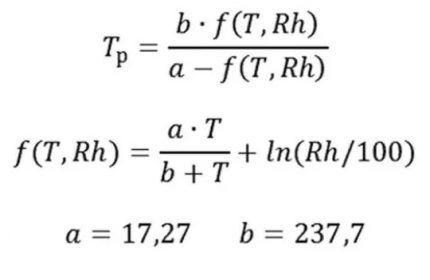
Method No. 2 - using a ready-made table
Experts have developed a table for instant calculations.Please note that the table provides approximate data. It shows temperature and humidity, and at their intersection you will find the dew point.

Method No. 3 - measuring instruments
Now there are several types of special devices for carrying out such measurements. For example, some thermal imager models, in addition to key characteristics, can display both the localization of the dew point and the room thermogram. They are used by professional builders and heating engineers.
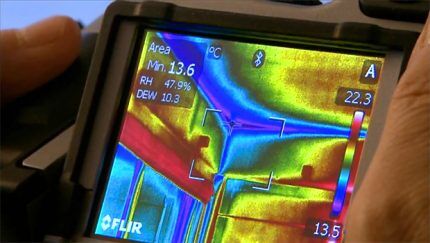
A portable thermal hygrometer will help you find out not only the temperature and humidity in the room, but also calculate the dew point.
A psychrometer will help measure two key indicators in a room: humidity and air temperature. The device consists of a wet and dry thermometer in one unit.
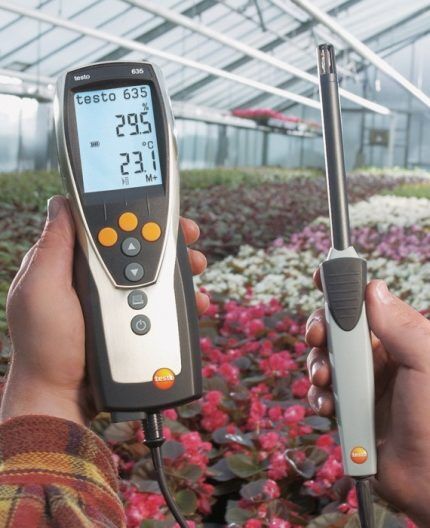
Method No. 4 - calculations using an online calculator
There are a lot of services that provide such calculators. At the same time, this method is considered one of the most unreliable, because as a result you can get numbers out of the blue or with a large error.
If you are unsure of the results obtained, then trust the professionals and contact a specialized company. They will analyze the walls and offer the best option.
Dew point localization
The location of the dew point depends on which side the insulation is located on. So, in a wall without insulation it will shift along the thickness of the wall depending on changes in air temperature and humidity. With a minimum temperature difference, it will be located in the thickness of the wall between the center and the outer surface.
Subsequently, the inside of the wall will remain dry. When its position is between the inner surface and the center of the wall, the latter will get wet inside during a sharp cold snap or during a period of frost.
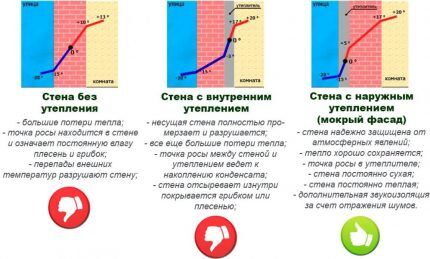
In the wall with insulation on the outside the dew point location will be optimal. Indeed, in this case it will be located inside the insulation, and thus the inner surface of the wall will be dry. This is the best option.
But, if the thickness of the insulation is chosen incorrectly, the dew point may shift, which can lead to the appearance of fungus, mold, and rapid destruction of the walls.
In the wall with insulation installed inside condensation forms in the wall closer to the living space, the temperature of the wall under the thermal insulation layer decreases, creating optimal conditions for mold growth.
Localization could be like this:
- between the center of the wall and the insulation, and during periods of frost or a sharp drop in temperature at their border;
- on the inner surface of the wall, which will be wet under the insulation throughout the winter;
- inside the insulation, which, like the wall underneath it, will be wet during the entire cold period.
As you can see, the location of the dew point has a significant impact on human comfort and health.
Consequences of incorrect calculations
When choosing materials for insulation, remember that one of the effective ways to protect external walls from moisture is to correctly arrange the layers of insulation.
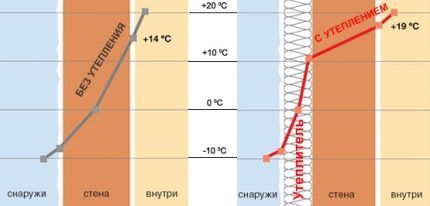
A dense layer that will not allow steam to pass through should be placed on the inside of the load-bearing wall, and a porous layer that allows moisture to pass through should be placed on the outside.
It is also necessary to create conditions for ventilation at the condensation point. In this case, the condensate will evaporate without obstacles.
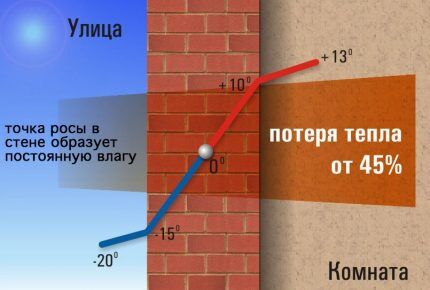
If the insulation was chosen incorrectly, then moisture will accumulate in it gradually and the thermal resistance number of the wall will decrease. Therefore, in the second, or maximum in the fifth, heating season, heating costs will increase, if this is a private house, the apartment will simply be much colder in winter.
Professional insulation is a long and expensive process. Today there are many materials for insulation. Do not try to save on them, as cheap materials will become unusable after a few heating seasons and begin to deteriorate.
There are several consequences of incorrect calculations, but some of them can negatively affect the quality of life. The main consequence will be constantly wet walls, as a result of fungus, mold, microbes on the walls, which entails the appearance of many chronic diseases.
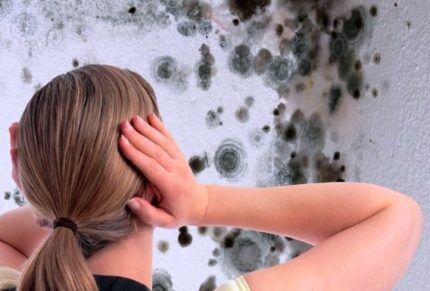
Since a damp room is difficult to heat, the comfort level drops. And high humidity inside such walls can cause respiratory diseases.
Another unpleasant consequence of incorrect calculations is the destruction of finishing materials - tiles crumble, bricks on the external wall crumble, and inside the room the surface on the walls will begin to swell.
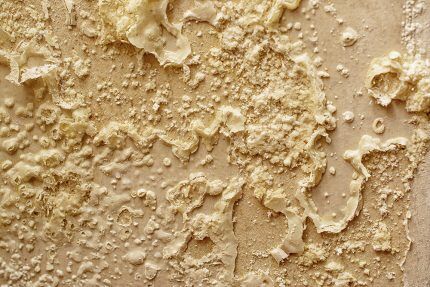
To correct the situation, you should contact specialists to analyze the condition of the walls and insulation. With the correct calculations, you can correct all mistakes and create comfortable and warm conditions in your home.
Will familiarize you with the rules and formulas for carrying out thermal engineering calculations for competent house design next article, which we highly recommend reading.
Conclusions and useful video on the topic
You can learn how to determine the dew point and what it is from the following video:
The following video will discuss methods of wall insulation and the correct choice of materials:
You can find out the dew point either independently or by contacting professionals. The dew point number allows a specialist to choose the right material and efficiently insulate the walls of a residential building or any other room.
Not only the warmth and comfort in the house, but also the health of its inhabitants depends on the accuracy of measurements. Professionals recommend insulating a wall from the inside only as a last resort and after professional consultation.
Please write comments and ask questions on controversial issues, publish photos and posts with your opinion in the block below.Share useful information and methods for determining dew point that are not described in the article. Tell us about your personal experience in resolving this issue.



